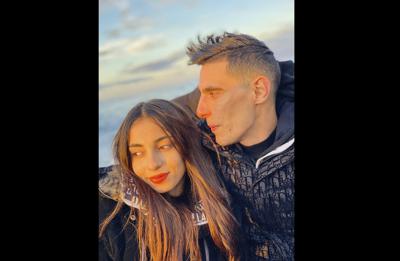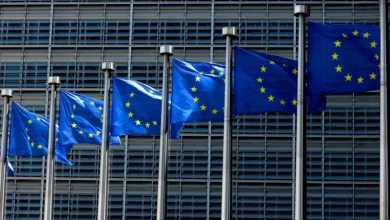
TUNIS, Tunisia (AP) — In a photo posted in November, 18-year-old Sabee al Saidi is shown wearing bright-pink lipstick as she leans from the side of a rickety wooden boat, a calm blue sea stretched out behind her. In a video, she smiles alongside a dozen other migrants, gesturing to a popular rap song.
A month later, Chaima Ben Mahmoude, 21, posted a similar video, waving as she made the crossing from Tunisia to Italy with her fiance in a boat crowded with migrants.
The two Tunisian women have sparked controversy with their posts — which show them on seemingly carefree trips across the Mediterranean, landing in Lampedusa, Italy, and then traveling around European cities taking selfies next to landmarks as they sport popular fashion brands. Many criticized them for “normalizing” a journey that leaves thousands dead each year.
According to the Missing Migrants Project, 2,048 people went missing in the Mediterranean in 2021, with 23,000 missing since 2014. Experts warn that al Saidi and Ben Mahmoude — social media influencers in Tunisia, with nearly 2 million followers on TikTok and Instagram between them — could inspire others to make the dangerous crossing.
“Social media is putting out a vision of Europe that is not accurate,” said Matt Herbert, research manager at the Global Initiative Against Transnational Organized Crime.
In the past, he said, the driver for migration was “the diaspora coming home for the summer. People would see their cousins wearing new, expensive clothes and aspire to be like that.”
TUNIS, Tunisia (AP) — In a photo posted in November, 18-year-old Sabee al Saidi is shown wearing bright-pink lipstick as she leans from the side of a rickety wooden boat, a calm blue sea stretched out behind her. In a video, she smiles alongside a dozen other migrants, gesturing to a popular rap song.
A month later, Chaima Ben Mahmoude, 21, posted a similar video, waving as she made the crossing from Tunisia to Italy with her fiance in a boat crowded with migrants.
The two Tunisian women have sparked controversy with their posts — which show them on seemingly carefree trips across the Mediterranean, landing in Lampedusa, Italy, and then traveling around European cities taking selfies next to landmarks as they sport popular fashion brands. Many criticized them for “normalizing” a journey that leaves thousands dead each year.
According to the Missing Migrants Project, 2,048 people went missing in the Mediterranean in 2021, with 23,000 missing since 2014. Experts warn that al Saidi and Ben Mahmoude — social media influencers in Tunisia, with nearly 2 million followers on TikTok and Instagram between them — could inspire others to make the dangerous crossing.
“Social media is putting out a vision of Europe that is not accurate,” said Matt Herbert, research manager at the Global Initiative Against Transnational Organized Crime.
In the past, he said, the driver for migration was “the diaspora coming home for the summer. People would see their cousins wearing new, expensive clothes and aspire to be like that.”

“With social media, it’s much more in your face and more accessible to everybody,” Herbert said.
Tunisia is one of the main departure points for migrants setting off from North Africa to Europe, with thousands of Tunisians joining those making the journey from elsewhere in Africa and the Middle East each year. While Tunisia was once a popular tourist destination with a burgeoning middle class, as the country’s economy deteriorated — with an 18% unemployment rate exacerbated by the impact of COVID-19 — migration attempts have soared.
In 2021, authorities intercepted more than 23,000 migrants trying to leave Tunisian shores. This number is starkly higher than in 2019, when around 5,000 people were intercepted, and dwarfs numbers recorded over the last decade.
A report by the Global Initiative Against Transnational Organized Crime pins the surge on rising unemployment and pessimism about Tunisian leaders’ ability to improve the situation. Last July, following nationwide anti-government protests, President Kais Saied suspended parliament and took on sweeping powers, raising fears of democratic backsliding.
The journey across the Mediterranean is known locally as the “harka” — a reference to the figurative “burning” of borders and the destruction of personal documents before undertaking the perilous crossing. The clandestine intrigue once surrounding the harka has faded in recent years as more people have migrated, and it is widely discussed on social media, in music and on TV.
While Ben Mahmoude’s and al Saidi’s posts sparked criticism, many also came to their defense, a reflection of how some see the harka as their only option to escape a country in crisis amid growing frustration over European Union visa restrictions. France recently slashed visas given to Tunisians by 30% — and to Algerians and Moroccans by half — accusing the countries of failing to cooperate over the return of their nationals who were in the country illegally.
“Shame on her? More like, it’s a shame for us!” posted one TikToker in response to criticism of al Saidi’s video. “She managed to make it to Italy, while we’re all stuck here in Tunisia.”
As she underwent two weeks’ COVID-19 quarantine at a detention center in Italy, Ben Mahmoude told The Associated Press she understood the risks of the journey. But financial difficulties and her inability to get a visa had “forced” her to do the harka.
“I didn’t find anything for myself in Tunisia,” she said in the interview conducted through Zoom. “I have a diploma in hairdressing and I couldn’t get any work in this field. … When I did, the monthly salary was really hopeless — around 350 dinar ($120). You cannot do anything with that. You can just use public transport and buy your lunch — that’s it.”
Ben Mahmoude, who like al Saidi grew up in a lower middle-class family in the coastal Tunisian city of Sfax, said all it took was a call to a friend of a friend. She paid 4,500 dinar ($1,560) for a place in the boat alongside 23 others.
Despite her smiles in the posts, Ben Mahmoude said the journey was terrifying. She described a moment when the boat rocked violently.
“I was so scared, I saw death right in front of me,” she said. “The fear was extraordinary, the sea was really agitated and there were lots of high waves. In the boat, we said a prayer and prepared ourselves for death. When they told us we had arrived in Italian waters, we couldn’t believe it.”
Still, Ben Mahmoude says she was prepared to risk death for the chance at a better life.
“I have lots of friends who did the harka and they found opportunities in Europe. They put hope in my heart that there is work, that there is a lot of money,” she said. “I want to change my life like they did.”
Wael Garnaoui, a psychologist researching the harka, says this hope is largely based on “the migration lie,” a phenomenon that he says has been intensified by social media.
According to Garnaoui, people see others go to Europe and observe their apparent success. They think that once in Europe, they can easily get papers, work and money. The reality is often very different: 2020 data from the European Commission showed that the unemployment rate for inhabitants from outside the EU was nearly 14%, compared to about 6% for the native-born population.
“So they go to the Eiffel Tower and take a selfie in a Lacoste T-shirt, take photos of expensive cars. .… They tell their family back home that everything is going well,” Garnaoui said. “If they say the opposite, everyone will mock them. They will point to other people and say: ‘If they did it, why can’t you?’”
“There is so much social pressure,” he said.
In the weeks since Ben Mahmoude and al Saidi made it to Europe, they have documented their shopping sprees, rides in BMWs and picture-perfect lattes. A photo of al Saidi riding an electric scooter in the historic French village of Le Puy-Notre-Dame got nearly 6,000 likes, while one of Ben Mahmoude beneath the Eiffel tower had 8,000. The photos and videos of their crossings garnered hundreds of thousands of likes and shares.
Although both women secured sponsorships in Tunisia that paid them for their social media endorsements of beauty products and local businesses, it’s unclear if they are making money from their posts in Italy and France.
But their posts do have influence in Tunisia, experts say.
Posts like theirs “demystify” a journey that might otherwise be too terrifying to undertake, said Herbert of the Global Initiative Against Transnational Organized Crime.
“One of the bars to migration is the fear of stepping out on the journey. … It’s scary. What these videos do, especially the videos of men and women at sea describing their journey, it confronts their fear with a visual reality that people can replace it with,” he said. “It lowers the mental bar to leaving.”
Ayla Bonfligio, an expert on migration at the Mixed Migration Centre, said rather than focusing on the draw posed by glowing social media posts like al Saidi’s and Ben Mahmoude’s, the real controversy should be “the fact that few legal pathways exist for youth to move.”
Citing France’s recent visa cuts, she said: “This use of migration as a political bargaining chip further limits legal pathways and it doesn’t reduce the demand for migration.”
As for Ben Mahmoude, she insists she’s not trying to encourage others to do the harka.
“I posted those videos because I always document my life on Instagram. Whether it’s at my house, when I’m out, when I’m at a cafe,” she said. “For me it was totally normal to publish stuff when I was doing the harka.”
For many, however, the harka has spelled only tragedy.
Chamseddine Marzouk, a volunteer for the Red Crescent in Zarzis, a coastal Tunisian town, has been burying the bodies of those trying to reach Europe for years. By building a makeshift cemetery, Marzouk wanted to raise awareness about the dangers of migration.
Then last summer Marzouk woke to find a letter from his wife saying that after multiple failed attempts to get visas, she and their grandchildren had left by boat for Europe. “Forgive me, I’m going to Italy. I have no other solution but the sea,” read the note.
“I found myself living the same situation that I’d been fighting for years,” Marzouk said.
If an accident happened, “I could be burying my family without knowing whose bodies they were. I was in shock for two nights, and felt such relief when they called and told me they had arrived.”




